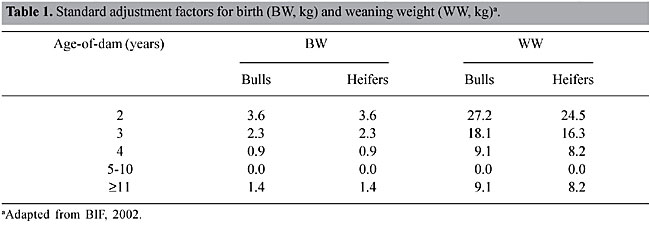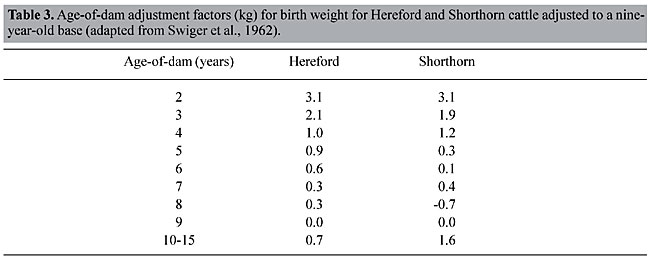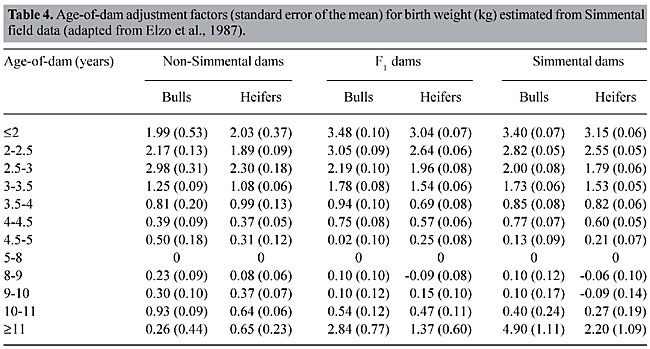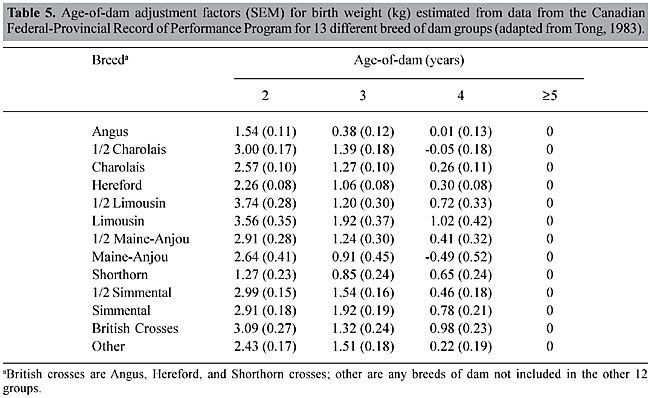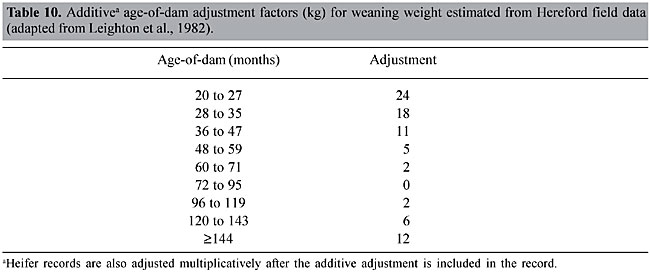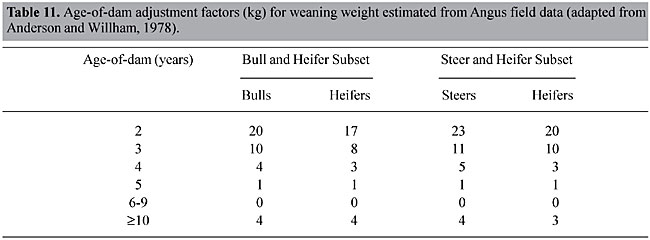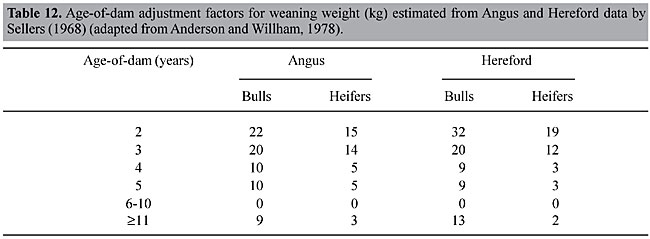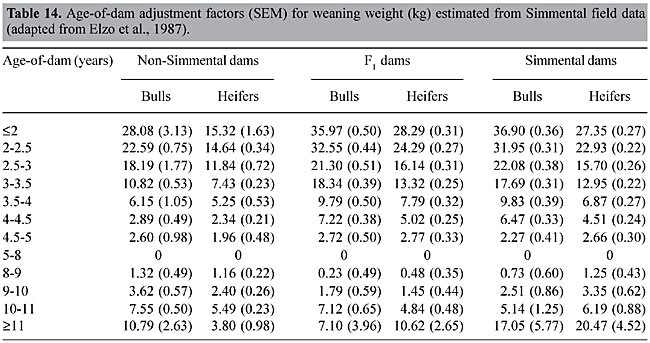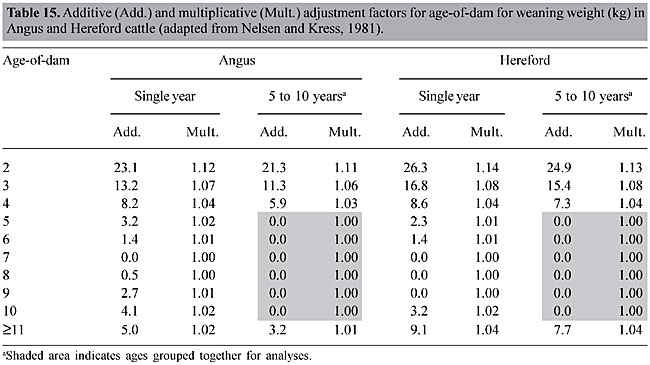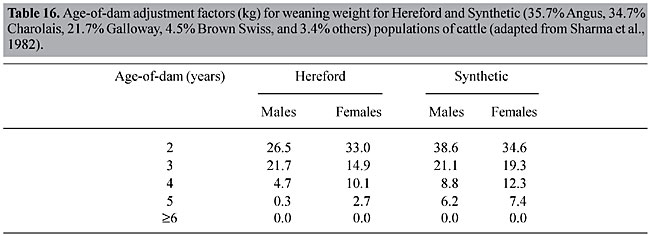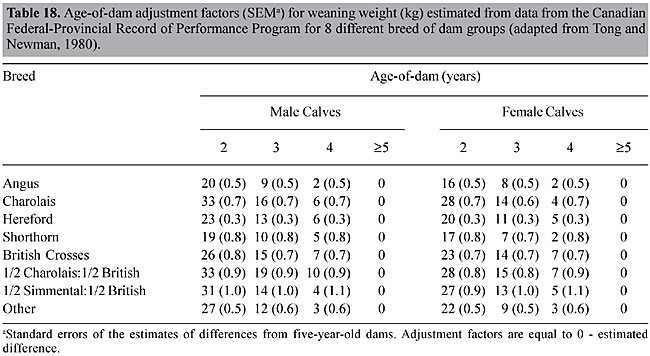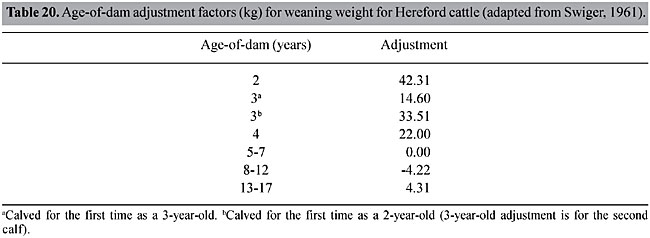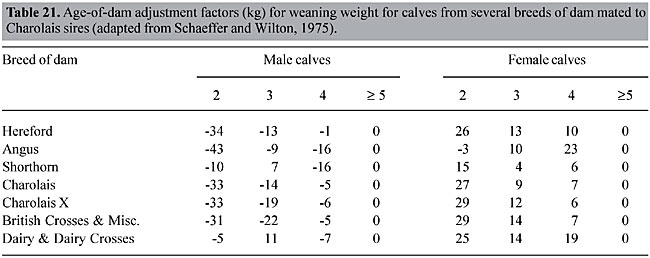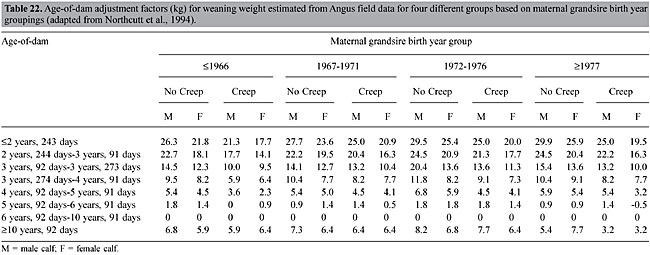
ABSTRACT. Age-of-dam adjustment factors are used to preadjust birth and weaning weight data for national beef cattle genetic evaluations. Adjustments are used in order to make the means of the different age-of-dam subclasses similar so that a fair comparison of animals can be performed. A review was made of various research studies that have estimated age-of-dam adjustment factors for birth weight and weaning weight of beef cattle. In general, birth weight age-of-dam adjustment factors are the same across the sexes, but weaning weight age-of-dam adjustment factors differ across the sexes, with heifer calves receiving smaller adjustments than their male counterparts. Additionally, adjustment factors vary greatly across breeds. Preadjustment of records is difficult to do because a perfect estimate of adjustments is not possible. A more appropriate method for adjusting for age-of-dam is to simultaneously adjust during national genetic evaluations. Key words: Adjustment factors, Beef cattle, Genetic evaluation INTRODUCTION Genetic evaluations are dependent on accurate adjustments for non-genetic factors of records of animals. If records were adjusted exactly, all known environmental, or non-genetic, effects would be adjusted out of each record so that accurate estimates of the genetic parameters, and consequently accurate estimates of the breeding values for each animal, can be obtained, but perfect adjustment factors are not possible. There are two ways that data can be adjusted for known environmental effects. First, these effects can be adjusted out of the data prior to analysis through the use of estimated adjustment factors or secondly, they can be adjusted simultaneously with the estimation of genetic parameters. If preadjusted, the magnitude of these effects must be estimated, whereas with simultaneous adjustment, the computational process estimates and adjusts during analysis. Traditionally, in the beef cattle industry, adjustment factors such as sex and age-of-dam are used for the premature weight traits (i.e., birth and weaning weights), whereas adjustment for contemporary groups is made simultaneously with the estimation of genetic parameters and/or breeding values. The effects for sex and age-of-dam are considered to be constant from analysis to analysis and the categories of factors are assumed not to change. Contemporary groups, however, change each time the records are analyzed. The Beef Improvement Federation (BIF) guidelines for age-of-dam adjustment factors (BIF, 2002) are shown in Table 1. Many breeds have developed their own adjustment factors. A summary of some of these is shown in Table 2.
The need for adjustment factors for sex and contemporary group effects is obvious. Bull calves generally grow faster than heifer calves and therefore it is not fair to compare heifers to their male counterparts without adjustment. Contemporary groups also need to be accounted for in analyses because not only will animals in different herds and areas of the country be treated differently, but groups of animals within a herd could also be treated differently. Adjustment for these effects is needed for fair genetic evaluation. Animals with what could be considered preferential treatment would have an unfair advantage if adjustments were not made. The need for age-of-dam adjustment factors is nearly as obvious. First-calf heifers are not physically or biologically mature. Nutrients they consume are partitioned not only into lactation, maintenance, and gestation, but also to their own growth. Therefore, calves from young cows are generally smaller, both at birth and at weaning, and have a disadvantage compared to their contemporaries with older dams. Adjustment factors help to correct this bias by scaling records for calves of young cows to what they could be expected to be if those young cows had been mature.
Similarly, cows will reach peak production at a mature age and then decrease in performance as measured by weight of their calves. These old cows are no longer as efficient as they were at younger ages and consequently their calves born at older ages would have smaller weights than calves born earlier in their life. The purpose of adjustment factors is to equalize means, as well as variances, among subclasses (Freeman, 1973). Adjustment factors that are used to preadjust the data can be multiplicative or additive. If subclass variances are heterogeneous, multiplicative adjustments may be required to adjust both the means and variances. If variances are homogeneous, but means are different, additive adjustment factors may be adequate to adjust the means to a common base. The latter situation has been found to be generally true for both birth and weaning weights. Subclass variances generally have been found to be homogeneous for birth and weaning weight in most studies and therefore additive adjustment factors are sufficient to equalize the means without affecting the variances. Many studies have been conducted to estimate appropriate adjustment factors to use for both birth and weaning weights of beef cattle. Most of these studies were conducted 20 or more years ago and due to the computing equipment available at the time were based on least squares analyses. The following is a partial review of some of these studies. ADJUSTMENT FACTORS FOR BIRTH WEIGHT In general, most studies have found age-of-dam adjustments for birth weight to be uniform across the sexes. Additionally, additive adjustments have been found to be sufficient. Age-of-dam adjustment factors are necessary for birth weight due to the uterine environment of mature cows compared to their younger and older contemporaries. Elzo et al. (1987) hypothesized that mature dams, which they defined as being 5 to 8 years of age, had a greater ability to provide the necessary nutrients and uterine environment for the developing fetus than do younger cows that are still developing themselves. Similarly, as cows become older, their ability to provide an adequate uterine environment may diminish. From analysis of birth weight of calves out of 4- to 9-year-old Hereford and Angus cows bred to Hereford, Angus, Red Poll, Brown Swiss, Gelbvieh, Maine-Anjou, and Chianina bulls at the U.S. Meat Animal Research Center (USMARC) in Clay Center, Nebraska, Gregory et al. (1978) found that age-of-dam was a significant (P < 0.01) source of variation when dams were assigned to two classes: 4 years old or mature (5 years old and older). For lamb data from Dorset, Hampshire, Shropshire, and Corriedale flocks at Cornell University, Blackwell and Henderson (1955) fit linear and quadratic regression coefficients of age of ewe on birth weight. The curvilinear relationship they found is similar to what is observed in cattle. Their estimates of the coefficients for the regression equation were 0.32 (0.052) and -0.03 (0.005) for linear and quadratic terms in Corriedale, Hampshire, and Shropshire data. For the Dorset flock, which was managed to lamb in both the spring and fall seasons, the linear coefficient was 0.12 (0.015) and the quadratic coefficient was nonsignificant at 0.00. The significant quadratic effect of age for most of the breeds would support the need for additional adjustment factors for older cows that are beyond peak production. Swiger et al. (1962), with data from Nebraska, estimated that calves out of 8- to 9-year-old dams had the heaviest birth weights. A summary of the age-of-dam effects are shown in Table 3 for two groups of cattle, a Shorthorn herd from the southeast portion of the state (Lincoln) and a Hereford herd from the northwest panhandle of the state (Fort Robinson).
Elzo et al. (1987) analyzed 839,292 field records from Simmental calves born from 1968 to 1985 (Table 4). They found that adjustment factors for age-of-dam should be different across the two sexes with adjustments for bull calves being larger. This difference was explained by the fact that bull calves were larger at birth and therefore probably required a better uterine environment than heifer calves, which are smaller, thus cows would be better able to meet the uterine environment needs of heifer calves than of bull calves. Factors were calculated separately for dams of different percent Simmental (0%, 50%, and ³75%). Simmental and F1 dams were similar. Mature dams were assumed to be 5 to 8 years old and with one exception, age-of-dam adjustment factors were positive for all other ages. Heifer calves out of F1 dams were the only category that was negative and significantly different from zero with an estimate of -0.09 kg (0.08). This estimate has no biological significance, though, because producers do not typically measure weight more precisely than by the pound (0.45 kg).
From an analysis of 191,535 birth weight records on several breeds for birth weight using data from the Canadian Federal-Provincial Record of Performance Program, Tong (1983) concluded that for all breeds, birth weight steadily increases with dam age until maturity (³5 years) with few exceptions. Four-year-old Maine-Anjou dams as well as 4-year-old 1/2 Charolais dams showed slightly heavier birth weights than mature dams of the same breed compositions. These deviations from maturity were not statistically different from zero (P > 0.05). Estimates for age-of-dam effects from the 13 different breed groups were determined (Table 5).
Sharma et al. (1982) analyzed data from Hereford and Synthetic cows (35.7% Angus, 34.7% Charolais, 21.7% Galloway, 4.5% Brown Swiss, and 3.4% others in 1978) collected from 1962 to 1978 at the University of Alberta Ranch at Kinsella. Age-of-dam adjustments for birth weight were not determined to be different for the two sexes (Table 6). The most appropriate adjustment was found to be an additive adjustment, which converted all records to a mature dam (6 years of age or greater) basis. Records for calves out of younger dams were generally lighter and therefore had to have positive adjustment factors added for both breed groups.
Van Vleck and Cundiff (1998) similarly found that there were no significant differences between sexes for age-of-dam effects for birth weight (Table 7). Mature dams were considered to be 5- to 9-year-old dams and solutions for effects of age consistently increased to maturity and then decreased for 10-year-old and older dams, indicating that calves out of young and old dams are born smaller than calves out of mature dams.
Using data from one purebred Hereford herd in southern Ohio, Swiger (1961) estimated age-of-dam adjustment factors for birth weight and, in contrast with other studies, found a difference due to sex of calf of 1.77 kg with bulls being heavier. There were 793 birth weight records available, collected from 1950 to 1958. Age-of-dam adjustment factors were set to a 2-year-old base, but when converted to a base more similar to other studies (i.e., 5- to 7-year-old dams), results are similar to what other researchers have found with birth weight adjustment factors steadily decreasing until maturity and then increasing again with older cows. Although age-of-dam groups were 2-, 3-, 4-, 5- to 7-, 8- to 12-, and 13- to 17-year-old dams, the 5- to 7-year-old and 8- to 12-year-old groups resulted in the exact same adjustment factors and could be considered to be the same group (Table 8).
Although only a brief summary of a few of the numerous studies to estimate birth weight age-of-dam adjustment factors, the general consensus is that age-of-dam adjustments are necessary and are generally uniform across sexes. Across breeds, there may be more variability. ADJUSTMENT FACTORS FOR WEANING WEIGHT Additive adjustment factors have been shown to be sufficient to adjust weaning weight data within sex (Koch et al., 1959; Brinks et al., 1961; Cundiff et al., 1966b). As previously reviewed, the consensus for birth weight records was that there is usually no sex by age-of-dam interaction, meaning that all calves can receive the same age-of-dam adjustment regardless of sex. Schaeffer and Wilton (1974) found that there was a significant age-of-dam by sex interaction with average daily gain from birth to weaning. Combining these two facts, it can easily be seen that age-of-dam adjustment factors for weaning will most likely be different for the sexes, which has been proven and supported in many studies. Age-of-dam effects have been found to be statistically significant (P < 0.01) for weaning weight of calves out of 4- to 9-year-old Angus and Hereford cows bred to Hereford, Angus, Red Poll, Brown Swiss, Gelbvieh, Maine-Anjou, and Chianina sires (Gregory et al., 1978). Dams were classified in one of two age-of-dam groups: 4 years old or 5 years and greater. This result indicates that cows are still gaining in efficiency and have not fully matured through four years of age. With lamb weaning weights, Blackwell and Henderson (1955) estimated linear and quadratic regression coefficients for the Hampshire, Shropshire, and Corriedale flocks to be 1.40 kg (0.46) and -0.14 (0.048), respectively. The coefficients estimated for the Dorset flock were not significant. As with birth weight, progeny records of very old females need adjustment as well as those from younger dams. Cundiff et al. (1966a) found significant effects of age-of-dam (P < 0.01) for weaning weight from 1959 to 1962 from the Oklahoma Beef Cattle Improvement Program. These effects account for seven percent of the total variance in weaning weight (Table 9).
Leighton et al. (1982), from an analysis of 382,075 weaning weight records from the American Hereford Association, found that sex of calf and age-of-dam were the only biologically significant fixed effects. Although region of the United States was also statistically significant, less than one tenth of a percent of the variation in weaning weight was accounted for and therefore was not considered to be biologically significant. This result is somewhat in contrast to the report of Cundiff et al. (1966b) who found that month of birth and type of management were also significant sources of variation, but these factors are typically accounted for with contemporary group designations in the current national cattle evaluations. The adjustment factors estimated for the Hereford data were similar to what has been found in other studies, but were identical for both sexes and required a multiplicative sex adjustment for heifer records (1.10 kg) after additive age-of-dam adjustments were used in order to correct all records to the base of a bull calf raised by a mature cow (Table 10).
Leighton et al. (1982) also found that the difference in weaning weight between bulls and heifers was 19 kg with bull calves being heavier. Weaning weight also increased with age-of-dam until dams reached maturity at five to six years of age and then decreased for cows older than ten years of age. They suggested an additive adjustment for age-of-dam to convert records to a mature dam basis and then a multiplicative adjustment to convert records to a bull calf basis. From 499,894 field data records from the American Angus Association, Anderson and Willham (1978) estimated age-of-dam adjustment factors for weaning weight for Angus cattle (Table 11). They looked at two different subsets of the data, one that contained only bulls and heifers and one that contained only steers and heifers. All three sexes had different adjustment factors, although the adjustments for bulls and steers were similar. Heifers had the adjustment factors that were the least in magnitude.
Anderson and Willham (1978) also summarized work that had been analyzed for the dissertation of Sellers (1968). For Angus bull data, the estimates for adjustment factors were much greater than those found by Anderson and Willham (1978). Heifer adjustment factors were also generally larger, but not as large as for bulls. Adjustment factors for Hereford dams were smaller than those found for Angus dams except at very young and old ages (Table 12).
Sellers et al. (1970) found that age-of-dam was a highly significant (P < 0.005) source of variation when analyzing 19,907 records from Angus and Hereford calves representing 157 herds from Angus and Hereford calves in the Iowa Beef Improvement Association program. Sexes were analyzed separately and estimates of age-of-dam correction factors were determined (Table 13) for bull, heifer, and steer calves. Mature cow, or peak production, was assumed for cows that were 6 to 12 years of age.
Elzo et al. (1987), using a sire-maternal grandsire model, found significant age-of-dam differences for weaning weight in Simmental field data which they attributed to differential milking ability in mature cows relative to their younger and older cows. As found in other studies, age-of-dam effects for bull and steers were significantly different compared to heifers (Table 14). They suggested that this was because dams that had not yet reached maturity or were beyond maturity were better able to meet the nutritional and environmental requirements of heifer calves than those of bull calves. Adjustments for non-Simmental cows were smaller in magnitude than adjustments for F1 or Simmental cows, which were similar.
Weaning weight adjustments were also shown to increase with increasing older ages by Burgess et al. (1954) using data from 546 Hereford calves. Age-of-dam effects, when converted to a mature cow (6 to 8 years old) basis, were 16.26 kg, 7.27 kg, and 14.04 kg for 2-year-old, 3- to 5-year-old, and 9-year-old and older cows, respectively. In contrast to most studies, Nelsen and Kress (1981) concluded that multiplicative age-of-dam adjustments were the most appropriate for Angus data in the Montana Beef Performance Association. Hereford data from the same database appeared to be more suited to additive adjustments. Data included 5902 Angus and 5950 Hereford records from 15 herds which had been collected between 1958 and 1973. The multiplicative effects used with the Angus data affected variation due to age-of-dam variation little, but was more important in reducing some of the sex by age-of-dam interaction variation. Both additive and multiplicative adjustment factors for each breed were determined (Table 15). These results further indicate that adjustment factors should be calculated separately for different breeds of cattle.
Sharma et al. (1982) analyzed data from Hereford and Synthetic cows as previously described at the University of Alberta Ranch at Kinsella. Adjustment factors for age-of-dam for weaning weight was found to be different for the two sexes (Table 16). Unlike Anderson and Willham (1978) who suggested that the most appropriate way to adjust records was to first use the additive age-of-dam adjustment and then use the multiplicative sex of calf adjustment, Sharma et al. (1982) found that the most appropriate adjustment sequence for their data was to first adjust multiplicatively for sex of calf, followed by an additive age-of-dam adjustment.
From an analysis of 822 Angus and 404 Hereford weaning weight records from the Fort Reno Livestock Research Station in El Reno, Oklahoma, Cardellino and Frahm (1971) developed age-of-dam adjustment factors to a mature cow (5 to 9 years old) base (Table 17). Breed by age-of-dam interaction was significant (P < 0.01), indicating that adjustment factors are different across breeds.
Tong and Newman (1980), using the same population as previously described, calculated age-of-dam adjustment factors for weaning weight. Each breed of dam was required to have a minimum of 1000 calves in each sex of calf by age-of-dam subclass. If not, the breed was classified in the “other breeds” category. After edits, 373,351 weaning records collected from 5421 herds between 1971 and 1977 were analyzed. Age-of-dam adjustment factors with a mature cow (5 years old and greater) base were calculated (Table 18). As found in other studies, calves increased in weight as their dams increased in age. Breed of dam and sex of calf had effects on the adjustment factors so that different factors were estimated for bull and heifer calves as well as for breeds of dam.
Van Vleck and Cundiff (1998) also found that weaning weight adjustment factors were different between the two sexes, but were significantly different (P < 0.05) only at the 2-year-old age-of-dam category with a difference of 10.27 kg and an associated standard error of the difference of 3.81 kg. The authors noted that this is the most important age-of-dam category as with common production systems, most cows will have a calf when they are 2 years of age, but fewer will have calves at later ages (Table 19).
From 748 weaning records collected from one Hereford herd in southern Ohio over a 9-year period, Swiger (1961) estimated age-of-dam (Table 20). The difference between 3-year-old dams that were calving for the first and second time was estimated to be nearly 19 kg, with calves of 3-year-old first calf heifers weighing more at weaning than calves of second calf cows. Because 2-year-old first calf heifers are farther from maturity and are partitioning nutrients to lactation, gestation, and their own growth, they probably are farther behind in development than their contemporaries which are raised to calve at 3 years of age. Although most heifers in the United States are currently developed to calve as 2 years old, these results indicate that attention should be made to those few heifers that do not have a calf until they are three because these calves may be overadjusted with the current adjustment system.
Schaeffer and Wilton (1975) analyzed weaning weights from the Canadian Department of Agriculture and the Alberta Provincial Record of Performance Programs. Records were from progeny of matings of Charolais, Limousin, and Simmental bulls to Hereford, Angus, Shorthorn, Chraolais, Charolais cross, Dairy, Dairy cross, Simmental, Simmental cross, Limousin cross, British cross, and miscellaneous cows. Age-of-dam subclass differences were estimated for each mating combination, but due to few records with Limousin and Simmental sires (45 and 70, respectively), only adjustment factors calculated from weights of progeny of the 444 Charolais sires were calculated (Table 21). Charolais x Simmental adjustments were also not determined as this mating only occurred in one age-of-dam x breed of sire x sex of calf subclass. With the exception of Angus dams, most breeds of dams required similar age adjustments as found in other studies.
Northcutt et al. (1994) found that age-of-dam adjustment factors estimated from Angus field data changed as year of birth of the maternal grandsire increased. Age-of-dam adjustment factors were estimated separately for four different groups categorized by maternal grandsire birth year (£1966, 1967-1971, 1972-1976, ³1977) using weaning weight records collected from 1970 to 1988. Adjustment factors were found to increase as the birth year of the maternal grandsire increased. They hypothesized that these differences could be due to changes in mature size of Angus cows or to an increased rate of maturing. Another suggested hypothesis was that the differences could be due to changes in environment and management of developing heifers. Their estimates are shown in Table 22. The authors suggested that the most appropriate way to adjust for age-of-dam would be to calculate adjustments jointly with estimation of breeding values so that the most current adjustments for the data can be used which would be more accurate than preadjusting the data prior to analysis for breeding values.
CONCLUSIONS A great deal of research has been conducted to estimate appropriate age-of-dam adjustment factors to be used for birth and weaning weights in beef cattle data. The general result has been that both traits are affected by age-of-dam and therefore adjustment factors are necessary for accurate national genetic evaluations. Additionally, it is commonly accepted that age-of-dam adjustments for birth weight are not affected by sex and therefore the same additive adjustment factors can be used for both bull and heifer calves. For weaning weight, adjustment factors are not the same for different sexes and therefore, each sex of calf requires a different age-of-dam adjustment factor. A summary of several studies shows that age-of-dam adjustments vary greatly, not only by breed, but also by analysis. The suggestion made in many of the studies for weaning weight adjustments is that adjustment factors should be analyzed and implemented on a within herd basis (e.g., Cardellino and Frahm, 1971) because herd or management effects can significantly affect age-of-dam effects (Nunn et al., 1978; Buchanan and Nielsen, 1979) and that herd effects can account for approximately 50% of the variance in weaning weight records (Burfening et al., 1978; Tess et al., 1979). Based on the studies reviewed, the most appropriate way to implement age-of-dam adjustment factors seems to be to either incorporate age-of-dam into the contemporary group classifications or include age-of-dam as a separate fixed effect. In either scenario, age-of-dam adjustments would be calculated simultaneously with estimates of breeding values so that preadjustment of the data would not be necessary. REFERENCES Anderson, J.H. and Willham, R.L. (1978). Weaning weight correction factors from Angus field data. J. Anim. Sci. 47: 124-130. BIF (1996). Guidelines for Uniform Beef Improvement Programs. Seventh edition. Beef Improvement Federation, Reno, NE, USA. BIF (2002). Guidelines for Uniform Beef Improvement Programs. Eighth edition. Beef Improvement Federation, Athens, GA, USA. Blackwell, R.L. and Henderson, C.R. (1955). Variation in fleece weight, weaning weight and birth weight of sheep under farm conditions. J. Anim. Sci. 14: 831-843. Brinks, J.S., Clark, R.T., Rice, F.G. and Kieffer, N.M. (1961). Adjusting birth weight, weaning weight and pre-weaning gain for sex of calf in range of Hereford cattle. J. Anim. Sci. 20: 363-367. Buchanan, D.S. and Nielsen, M.K. (1979). Sire by environment interactions in beef cattle field data. J. Anim. Sci. 48: 307-312. Burfening, P.J., Kress, D.D., Friedrich, R.L. and Vaniman, D. (1978). Calving difficulty and growth rate of Simmental-sired calves. II. Genetic parameter estimates. J. Anim. Sci. 46: 930-936. Burgess, J.B., Landblom, N.L. and Stonaker, H.H. (1954). Weaning weights of Hereford calves as affect by inbreeding, sex, and age. J. Anim. Sci. 13: 843-851. Cardellino, R. and Frahm, R.R. (1971). Evaluation of two types of age-of-dam correction factors for weaning weight in beef cattle. J. Anim. Sci. 32: 1078-1083. Cundiff, L.V., Willham, R.L. and Pratt, C.A. (1966a). Effects of certain factors and their two-way interactions on weaning weight in beef cattle. J. Anim. Sci. 25: 972-982. Cundiff, L.V., Willham, R.L. and Pratt, C.A. (1966b). Additive versus multiplicative correction factors for weaning weight in beef cattle. J. Anim. Sci. 25: 983-987. Elzo, M.A., Quass, R.L. and Pollak, E.J. (1987). Effects of age-of-dam on weight traits in the Simmental population. J. Anim. Sci. 64: 992-1001. Freeman, A.E. (1973). Age adjustment of production records: history and basic problems. J. Dairy Sci. 56: 941-946. Gregory, K.E., Cundiff, L.V., Smith, G.M., Laster, D.B. and Fitzhugh Jr., H.A. (1978). Characterization of biological types of cattle - cycle II: I. Birth and weaning traits. J. Anim. Sci. 47: 1022-1030. Koch, R.M., Gregory, K.E., Ingalls, J.E. and Arthaud, R.L. (1959). Evaluating the influence of sex on birth weight and pre-weaning gain in beef cattle. J. Anim. Sci. 18: 738-744. Leighton, E.A., Willham, R.L. and Berger, P.J. (1982). Factors influencing weaning weight in Hereford cattle and adjustment factors to correct records for these effects. J. Anim. Sci. 54: 957-963. Nelsen, T.C. and Kress, D.D. (1981). Additive and multiplicative correction factors for sex and age-of-dam in beef cattle weaning weight. J. Anim. Sci. 53: 1217-1224. Northcutt, S.L., Wilson, D.E. and Hoekstra, J.A. (1994). Effect of positive genetic trend for mature size on age-of-dam adjustment factors for weaning weight in Angus field records. J. Anim. Sci. 72: 828-832. Nunn, T.R., Kress, D.D., Burfening, P.J. and Vaniman, D. (1978). Region by sire interaction for production traits in beef cattle. J. Anim. Sci. 46: 957-964. Schaeffer, L.R. and Wilton, J.W. (1974). Age-of-dam, sex and environmental interactions affecting preweaning average daily gains of beef cattle. Can. J. Anim. Sci. 54: 183-190. Schaeffer, L.R. and Wilton, J.W. (1975). Predicting beef sire genetic values for growth traits from progeny records. J. Anim. Sci. 41: 1592-1599. Sellers, H.I. (1968). The effect of certain factors on weaning weight and weaning grade of beef cattle. Unpublished Ph.D. thesis, Library, Iowa State University, Ames, IA, USA. Sellers, H.I., Willham, R.L. and DeBaca, R.C. (1970). Effect of certain factors on weaning weight of beef calves. J. Anim. Sci. 31: 5-12. Sharma, A.K., Willms, L., Hardin, R.T. and Berg, R.T. (1982). Sex of calf and age-of-dam adjustments for some performance traits in two populations of beef cattle. Can. J. Anim. Sci. 62: 699-708. Swiger, L.A. (1961). Genetic and environmental influences on gain of beef cattle during various periods of life. J. Anim. Sci. 20: 183-188. Swiger, L.A., Koch, R.M., Gregory, K.E., Arthaud, V.H., Rowden, W.W. and Ingalls, J.E. (1962). Evaluating pre-weaning growth of beef calves. J. Anim. Sci. 21: 781-786. Tess, M.W., Kress, D.D., Burfening, P.J. and Friedrich, R.L. (1979). Sire by environment interactions in Simmental-sired calves. J. Anim. Sci. 49: 964-971. Tong, A.K.W. (1983). Breed averages and age-of-dam adjustment factors for birth weight of beef cattle. Can. J. Anim. Sci. 63: 7-15. Tong, A.K.W. and Newman, J.A. (1980). Additive age-of-dam adjustment factors for weaning weight of beef cattle. Can. J. Anim. Sci. 60: 11-19. Van Vleck, L.D. and Cundiff, L.V. (1998). Sex effects on breed of sire differences for birth, weaning, and yearling weights. J. Anim. Sci. 76: 1528-1534. |
|
